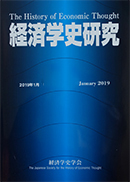Volume 55, Issue 2
Displaying 1-18 of 18 articles from this issue
- |<
- <
- 1
- >
- >|
-
2014Volume 55Issue 2 Pages 1-19
Published: 2014
Released on J-STAGE: August 23, 2019
Download PDF (896K) -
2014Volume 55Issue 2 Pages 20-36
Published: 2014
Released on J-STAGE: August 23, 2019
Download PDF (860K) -
2014Volume 55Issue 2 Pages 37-53
Published: 2014
Released on J-STAGE: August 23, 2019
Download PDF (955K) -
2014Volume 55Issue 2 Pages 54-72
Published: 2014
Released on J-STAGE: August 23, 2019
Download PDF (876K) -
2014Volume 55Issue 2 Pages 73-91
Published: 2014
Released on J-STAGE: August 23, 2019
Download PDF (868K) -
2014Volume 55Issue 2 Pages 92-105
Published: 2014
Released on J-STAGE: August 23, 2019
Download PDF (843K) -
2014Volume 55Issue 2 Pages 106-108
Published: 2014
Released on J-STAGE: August 23, 2019
Download PDF (780K) -
2014Volume 55Issue 2 Pages 109-115
Published: 2014
Released on J-STAGE: August 23, 2019
Download PDF (803K) -
2014Volume 55Issue 2 Pages 116-117
Published: 2014
Released on J-STAGE: November 28, 2019
Download PDF (772K) -
2014Volume 55Issue 2 Pages 118-119
Published: 2014
Released on J-STAGE: November 28, 2019
Download PDF (711K) -
2014Volume 55Issue 2 Pages 120-121
Published: 2014
Released on J-STAGE: November 28, 2019
Download PDF (722K) -
2014Volume 55Issue 2 Pages 122-123
Published: 2014
Released on J-STAGE: November 28, 2019
Download PDF (722K) -
2014Volume 55Issue 2 Pages 124-125
Published: 2014
Released on J-STAGE: November 28, 2019
Download PDF (711K) -
2014Volume 55Issue 2 Pages 126-127
Published: 2014
Released on J-STAGE: November 28, 2019
Download PDF (742K) -
2014Volume 55Issue 2 Pages 128-129
Published: 2014
Released on J-STAGE: November 28, 2019
Download PDF (728K) -
2014Volume 55Issue 2 Pages 130-131
Published: 2014
Released on J-STAGE: November 28, 2019
Download PDF (728K) -
2014Volume 55Issue 2 Pages 132-133
Published: 2014
Released on J-STAGE: November 28, 2019
Download PDF (728K) -
2014Volume 55Issue 2 Pages 134-136
Published: 2014
Released on J-STAGE: November 28, 2019
Download PDF (805K)
- |<
- <
- 1
- >
- >|
